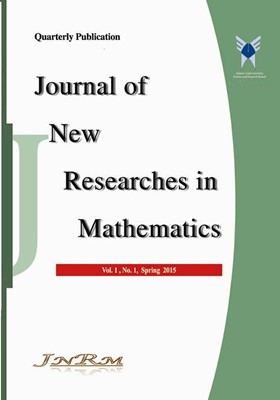Bag Filter Design using Neural Network Algorithm and Structural Equation Modeling (Case Study: Cement Factories)
Subject Areas : Statistics
Masoomeh Zeinalnezhad
1
![]() ,
Towhid Pourrostam
2
,
Towhid Pourrostam
2
![]()
1 -
2 -
Keywords: مدلسازی معادلات ساختاری, فیلترهای کیسهای, دادهکاوی, شبکه عصبی, صنعت سیمان,
Abstract :
Although data-driven modeling is now widely used to improve the processes of manufacturing organizations, it is less commonly used in the design of industrial machinery and equipment. In this study, according to the environmental pollution of the cement industry development, bag filters were designed to control and purify polluted air. Accurate calculation of the dimensions of the bag filter can play a significant role in reducing the pollution of cement factories and their economic justification. Therefore, the aim is to take into account the key parameters and provide an efficient method to calculate the optimal bag dimensions required for each filter using the analysis of available data. For this purpose, data mining techniques and structural equation modeling were used. Important parameters in the design of bag filters are temperature, pressure, percentage of inlet dust, dust granulation, dust moisture content, particle type and flammability of materials. Due to the stability of some parameters and non-flammability of particles in cement production, only three factors, dust flow rate, dust volume, and dust size were modeled. The results showed that the Ensemble neural network algorithm along with Boosting can predict the required area of the bag with 95.4% accuracy. Also, in each bag filter, the dust flow rate of 80% was effective in calculating the required surface area of the fabric, and the dust volume and size factors, with 15% and 6%, respectively, were of secondary and tertiary importance.
[1] S. Ameraoui, A. Boutaleb, N. Souiher, D. Berdous. Investigation of potential accumulation and spatial distribution of heavy metals in topsoil surrounding the cement plant of Meftah (southeastern Algiers region, Algeria). Arabian Journal of Geosciences.10(21), 464 (2017)
[2] K. Scrivener, A. Ouzia, P. Juilland, A.K. Mohamed. Advances in understanding cement hydration mechanisms. Cement and Concrete Research. 124, 105823 (2019)
[3] Cement Industry Employers Associationhttp://cementassociation.ir
[4] M. Ebrahimi, S.M.T.F. Ghomi, B. Karimi. Application of the preventive maintenance scheduling to increase the equipment reliability: Case study-bag filters in cement factory. Journal of Industrial and Management Optimization. 16(1), 189-205 (2020).
[5] A. Bhargava. Design of Bag Filter for the Control of Dust Emissions for a Cement Plant. International Journal of Scientific Development and Research. 1 (3) (2016).
[6] J.B. Hayes, J. Wang, J.G. Roessler, D. Deford, T.G. Townsend. Evaluation of leaching of trace metals from concrete amended with cement kiln baghouse filter dust. Resources, Conservation and Recycling. 94, 92-98 (2015).
[7] H. Zermane, H. Mouss, T. Oulmi, S. Hemal. Fuzzy-based process control system of a bag-filter in cement manufacturing plant. 16th International Conference on Systems and Control, 7958740, 109-114 (2017).
[8] D.R. Nhuchhen, S.P. Sit, D.B. Layzell. Towards net-zero emission cement and power production using Molten Carbonate Fuel Cells. Applied Energy. 306,118001 (2022).
[9] C.W. Purnomo, W. Budhijanto, M. Alfisyah, M. Triyono. Improvement of cement plant dust emission by bag filter system. IOP Conference Series: Materials Science and Engineering, 316(1), 012031 (2018).
[10] J.I. Bhatty. Innovations in Portland Cement Manufacturing. Portland cement Association, 740-745 (2004).
[11] J.D. McKenna, D. Furlong. Fabric filters, In A. J. Buonicore and W. T. Davis (Eds.), Air Pollution Engineering Manual. New York, Van Nostrand Reinhold (1992).
[12] G. Habert, S.A. Miller, V.M. John, et al. Environmental impacts and decarbonization strategies in the cement and concrete industries. Nat Rev Earth Environ 1, 559–573 (2020).
[13] FLSmidth.com
[14] P.S. Abhishek, P.N. Ramachandran. Design of Pleated Bag Filter System for Particulate Emission Control in Cement Industry. International Research Journal of Engineering and Technology. 2(5) (2015).
[15] J. Brito, R. Kurda. The past and future of sustainable concrete: A critical review and new strategies on cement-based materials. Journal of Cleaner Production. 281, 123558 (2021).
[16] A. Mohammed, S. Rafiq, W. Mahmood, H. Al-Darkazalir, R. Noaman, W. Qadir, K. Ghafor. Artificial Neural Network and NLR techniques to predict the rheological properties and compression strength of cement past modified with nanoclay. Ain Shams Engineering Journal. 12 (2), 1313-1328 (2021).
[17] J.L. García-Alcaraz, J.R. Díaz-Reza, J.L. Hernandez, G. Cortes-Robles. The Application of Structural Equation Models in Industry: Tendencies, International Journal of Management Sciences. 4(10), 429-444 )2014).
[18] A.A. Shubbar, M. Sadique, H.K. Shanbara, K. Hashim. The Development of a New Low Carbon Binder for Construction as an Alternative to Cement. Advances in Sustainable Construction Materials and Geotechnical Engineering. Lecture Notes in Civil Engineering. 35 (2020).
[19] Z.H. Zhou, J. Wu, W. Tang. Ensembling neural networks: Many could be better than all. Artificial Intelligence. 174 (18), 1570 (2010).


